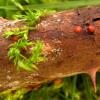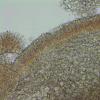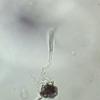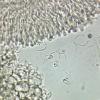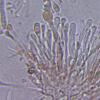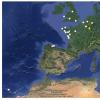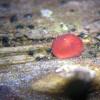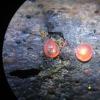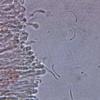
18-12-2025 21:17
Pol DebaenstThe identification took me to Byssonectria deformi

15-12-2025 07:09
 Danny Newman
Danny Newman
indet. Rutstroemiaceae sp. on unk. fallen leavesMc

19-12-2025 10:10
Patrice TANCHAUDBonjour, récolte réalisée en milieu dunaire, a

18-12-2025 17:23
 Bruno Coué
Bruno Coué
Bonjour,je serais heureux d'avoir votre avis sur c

18-12-2025 18:07
Margot en Geert VullingsThese plumes were found on rotten wood.They strong

17-12-2025 18:35
 Michel Hairaud
Michel Hairaud
Bonjour à tous/Hi to everyone I am passing along

15-12-2025 15:48
 Danny Newman
Danny Newman
Melanospora cf. lagenaria on old, rotting, fallen

15-12-2025 15:54
 Johan Boonefaes
Johan Boonefaes
Unknown anamorph found on the ground in coastal sa

15-12-2025 21:11
 Hardware Tony
Hardware Tony
Small clavate hairs, negative croziers and IKI bb
Found on dead stalk of Rubus lying on the ground:
FRB: ruby red, < 1.7 mm, dry: flat and semitranslucent, moist: swollen, cushonlike
Asci :36,42-37,92 x 4,03-4,61 µm,
Sspores: filiform strongly curved 7,80-11,89 x 0,82-1,69 µm (length with curve: 11,94-17,52 µm)
Paraphyses: filiform, apices swollen, knoblike
Texture: globulosa
Thanks to this fantastic site I can determine these apothecia: orbilia rubrovacuolata. Is that correct?
Orbilia's frustrate me, they confront me with my own shortcomings on mushroom knowledge and with the shortcomings of my microscope. With oil-immersion and a magnification of 1000 I am unable to get sharp photos.
I have no literature on this asco, so am I right?
Greetings,
François Bartholomeeusen

Bonsoir François,
Oui, Ascofrance est un outil formidable pour chacun d'entre nous et nous avons tous aussi la chance que Zotto ait généreusement diffusé ses connaissances par ses DVD et son site.
Juste une rapide remarque avant que Zotto n'apporte des précisions (notamment sur la documentation) car à ma connaissance cette espèce n'est pas encore publiée mais connue de beaucoup de mycologues. Pour ma part , je l'ai récoltée en Normandie, en Bretagne et en Asturies , soit le long de la côte atlantique , mais pas encore dans ma région du Centre Ouest. Cette récolte est elle aussi proche de la côte ?
La couleur des paraphyses et la forme des spores concordent bien, mais la couleur des apothécies me semble un peu dénaturée, peut être par un renfort du contraste ?
Amitiés. Michel

sans doubt!
Your microphotos are not bad, and I do likewise take my pics at 1000x oil, without using the zoom. Is your spore photo done with 400x? I could imagine that you need perhaps more light to achieve a shorter shutter speed which makes tremblng spores sharper.
It is true what Michel says, the species was not yet found in Charente-Maritime, but it starts to occur just a bit north (see map).
I would be pleased to include your collection data in the monograph. Perhaps you have coordinates of the place?
Zotto
Grâce à la couleur frappante de l'apotheses je suis réussi à trouvée les ascos sur terre sur une vieille tige de rubus, près de chez moi.
HA la belle France.... mais j'habite en Belgique, Anvers (province) dans la ville de Turnhout, à environ 200 km de la côte belge. Ci joint deux photos de l'apothesia.
Merci pour votre reponse,
François
Indeed the picture with spores is taken with magnification 400 x. Attached a picture with magnification 1000 x. It seemed as if the spores were swimming like an amoeba, so difficult to photograph! In annex the coordinates:
Found on 15 februari 2016, Belgium, province of Antwerp, city Turnhout in the nature reserve Frans Segers in Turnhout
WGS84 lat 51.297026201583286 – lng 4.923405871450086
IFBL B55723
Thanks en good evening,
François

my shutter speed is about 1/30 or even shorter, and herewith it does not trouble when spores move. But the problem I see on your photo is rather that the spores do not lie in a plane. This is almost unavoidable. Usually the spores settle on the bottom after some time and then it will produce better photos.
By the way, your hyperexact values are perhaps too wide, I never saw spores outside the range of (8.5–)9–12(–13) × (0.8–)0.9–1.2(–1.3).

Merci François,
Hi Zotto,
I guess from your map that the most French southern collection in in Vendée . Is that correct ? Otherwise, it seems that the species would rather prefer ''colder '' areas (acid soil ?), which may explain the absence from the South West coast. (unless it shows the absence of mycologists interested in Orbilias)
Michel
I sometimes allow ascospores to shoot onto (or make mounts in) a drop of 1% methyl cellulose solution placed on a slide. It is viscous, effectively slowing down the ascospore movement and making photography easier, and does not seem to affect spore dimensions or the vitality of the ascospores.
Thanks for the tip; I will have to expand my chemical collection!
Greetings,
François

I have a simplified geological small map of entire Europe showing cretaceous and tertiary sediments in Aquitaine and Cambrian in Brittany. It may well be that acidity of the soil plays a role. But some collections appear to fall in Cretaceous areas.
It is true that the southermost samples in France are from Vendee. maybe the fungus does not like the Charente-Maritime area. :-)
From the climate I think Vendee and Charente-Maritime are too similar to explain the absence.
Francois: if you keep the sample in a herbarium please tell me the number.
Zotto
Fast vergessen! Die Seriennummer des Exsicaat in meinem Herbarium: 20160215FS01
Mit freundlichen Grüßen,
François

In der Einleitung zur Monografie erklären wir die verwendeten Herbarabkürzungen und geben da immer den Wohnort des Finders an. Is es so richtig?
F.B. = F. Bartholomeeusen (Turnhout) ?
Gruß
Zotto
Grüßen,
François

